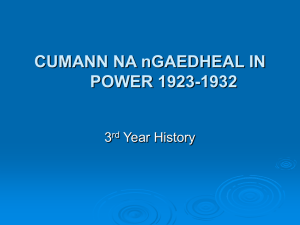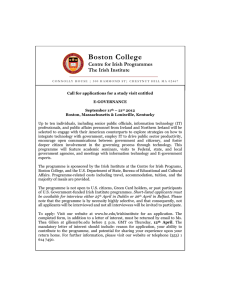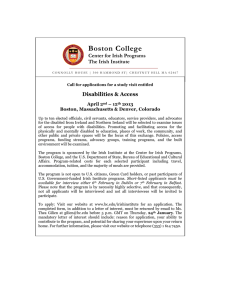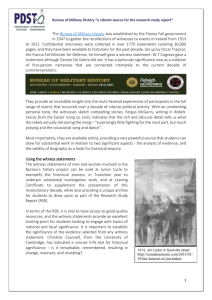Women in Irish Political Life Lecture 14
advertisement
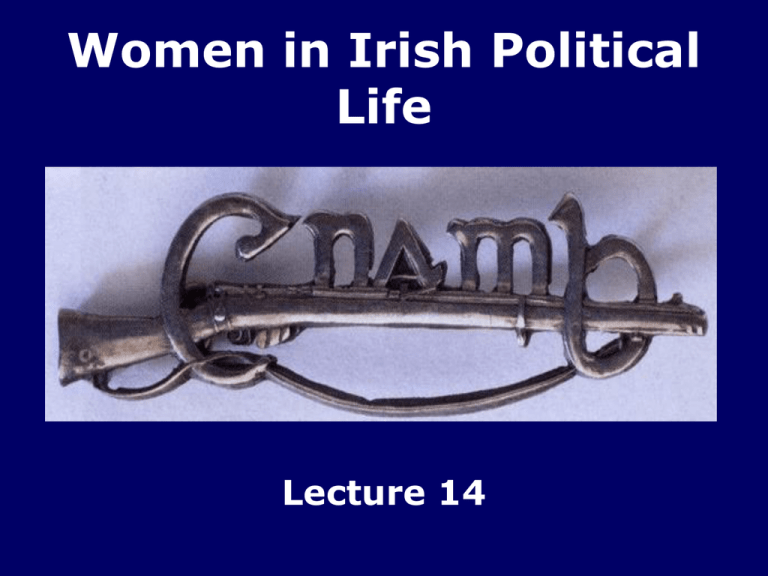
Women in Irish Political Life Lecture 14 ‘A significant minority of Irish women had become increasingly articulate and active in feminist, nationalist and labour concerns. To the number of nationalist women involved before and during the Rising of 1916, many thousands more were added in the wake of the Rising. From this point up to the bitter political divisions caused by the Treaty in 1922, such women played a significant role in the development of the emerging state.’ • Cullen Owens, R, A Social History of Women in Ireland, p251. ‘It is generally assumed that nineteenthcentury Irish politics were a function of public life, a male activity in which women played little if any role. Political historians pay scant attention to the role of women in political life, seeing it as either peripheral, or of small consequence. Women, of course, were not voters, nor did they have access to high political office in the nineteenth century. Although individual women such as Isabella Tod and Anna Haslam can be regarded as politicians, for most of the nineteenth century Irish women were excluded from formal male political culture.’ Maria Luddy, ‘Women and Politics in NineteenthCentury Ireland’ in Women and Irish History, p89. Ladies’ Land League Fanny Parnell (18491882) Founded in New York in October 1880 Dissolved in August 1882 Raised funds Oversaw the housing of evicted tenants Visible role in Irish political life Some women were radicalised by their involvement and became important national figures – Jenny Wyse Power and Hannah Lynch Contagious Diseases Acts • Series of acts introduced in the 1860s to reduce the army’s vulnerability to VD • 1869: Ladies’ National Association for the Contagious Diseases Acts est. Branches set up in Ireland • 1886: Contagious Diseases Acts repealed Local franchises • 1887: women householders in Belfast get the municipal vote • 1896: Irish women can vote for, and stand as, Poor Law Guardians • 1898: Local government franchise women have the right to vote for local councils, and to sit on district councils, but not on county councils. Early Suffrage • 1872 first suffrage society est. in Belfast by Isabella M S Tod • 1876 first suffrage society est. in Dublin by Anna and Thomas Haslam Anna & Thomas Haslam, early pioneers of Irish feminism 1896: Dublin Women’s Suffrage Association (est. 1876) had 43 members 1912: IWFL (est. 1908)had 1000 members, 50 of whom were active 1909: Irish branch of the Conservative and Unionist Women’s Suffrage Association founded 1911: Munster Women’s Franchise League established 1913: Church League for Women’s Suffrage set up (Anglican) 1915: Irish Catholic Women’s Suffrage Association founded Carson and Bonar Law confronted by Margaret Connery of the IWFL in Dublin c. 1912 Anti-suffrage demonstration in Strabane, Co. Tyrone, c. 1910 Ulster Women’s Unionist Council • Founded in January 1911 to support male unionists • 200,000 members in 1913 • Early 1914 approx. 3000 women had enlisted in the UVF • Trained in signalling, as ambulance and despatch riders, postal workers, typists and intelligence workers Cumann na mBan member Sighle Humphreys ‘I had a good deal of prejudice to overcome on the part of the parents, who did not mind their boys taking part in a military movement, but who had never heard of, and were reluctant to accept, the idea of a body of gunwomen. It was, of course, a rather startling innovation and, in that way, Cumann na mBan can claim to have been the pioneers in establishing what was undoubtedly a women's auxiliary of an army. I fully understood this attitude and eventually, in most cases, succeeded in overcoming this prejudice.’ Bridget O’Mullane, Witness Statement 450. Aims of Cumann na mBan 1. To advance the cause of Irish liberty 2. To organise Irishwomen in furtherance of this object 3. To assist in arming and equipping a body of Irishmen for the defence of Ireland 4. To form a fund for these purposes to be called the ‘Defence of Ireland Fund’ Cumann na mBan Cumann na mBan reciting the rosary in their ranks outside Mountjoy prison • Wednesday, April 26th. 19 chickens captured from messenger boy. Quiet day. We cooked the chickens for dinner, having to take them up out of the pots with bayonets, not having any forks or utensils for cooking. Dinner was very successful. • Thursday, 27th. Three live calves captured; one was killed by a Volunteer who was a butcher (Bob Holland) for dinner for Friday. (God forgive us). • Friday, 28th. Up early for breakfast; we fried veal cutlets and gave the men a good feed. We had a meat dinner, potatoes, etc. 9 chickens commandeered. Rose McNamara, Vice Commandant of the Cumann na mBan contingent in the Marrowbone Lane distillery, Easter 1916 Elizabeth O’Farrell ‘My home was a centre for the receipt and despatch of despatches. It was convenient for Seán Sharkey, the Battalion I/O, and for Seán Cooney, who, as a rule, took charge of all despatches arriving in Clonmel. Myself and my children often delivered despatches to Scroutea, Derrinlar and Newcastle when it was considered unsafe for Volunteers to leave town with them. As a camouflage, I usually carried a camera, and if held up by police or military, I was supposed to be out photographing.’ Mrs M.A. McGrath, Witness Statement 1704
